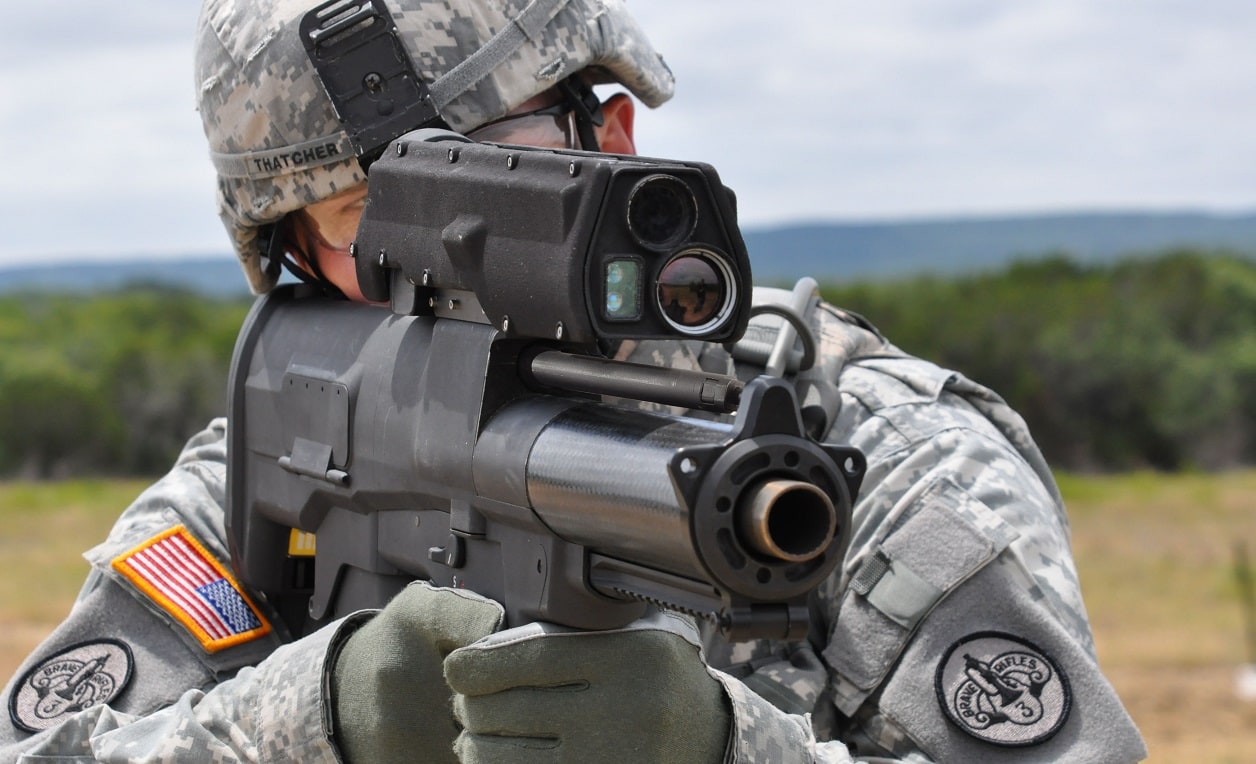Key Points: The XM25 “Punisher,” a revolutionary programmable grenade launcher designed to improve soldier lethality, was canceled in 2017 despite promising early results.
-The weapon had a 600m effective range for point targets, airburst capability, and programmable grenades that could hit targets in trenches, buildings, or behind cover.
-Initial tests in Afghanistan were successful, but issues such as double-feed malfunctions, limited ammunition capacity, and weight concerns led to mixed reviews.
-Despite its potential, including being 300% more lethal than traditional launchers, the XM25 faced operational challenges and a lack of funding, raising questions about whether it was canceled prematurely.
Did The XM25 Grenade Launcher Get Canceled Too Soon?
When news came out that the Army would be testing a new programable grenade launcher for the troops in the war in Afghanistan around 2010, I was intrigued. However, by 2013, the testing program was shut down, and the project was canceled in 2017.
Was the XM25 shut down too soon?
Like many other vets, I wondered why the military shelved the program so soon. Giving troops tools to become more versatile and lethal is always a good thing. The troops nicknamed the weapon the “Punisher.” Military writer Brent M. Eastwood likened the design to what Warrant Officer Ripley carried in the film Aliens. Brilliant.
The experimental weapon’s moniker was especially true when the XM25’s capabilities were reported. Soldiers carried the launcher-style gun like a rifle in a bullpup design. The box magazine was located behind the pistol grip and carried five programable 25mm grenades. The Army initially wanted 12,500 XM25s.
High Expectations Result From Increased Ranges
The XM25 had more than double the effective range of the M203, currently carried by the armed services. The maximum effective range of the weapon was 600m at point targets, vs. 150m for the 203. Area targets could be effectively engaged at 700m vs. 350m of the 203.

XM25 Punisher. Image Credit: US Army.
But the best feature was the airburst design, which according to Army testing was 300 percent more lethal than point-detonated grenades fired by the 203. The airburst would be invaluable for use over trenches or fighting positions, inside buildings, tunnels, or the far side of a hill.
The system’s basis is that the grenades are programable, and how the semi-smart weapon can be used. The grenadier will acquire a target and activate the laser rangefinder to determine the exact distance to the target. The grenadier can fine-tune the detonation delay of the grenade by adding or subtracting distance.
Each grenade has an implanted microchip, which downloads data to the chambered grenade. Once the grenadier has fired the weapon, the microchip determines the distance by the number of spins the projectile takes to reach the target.

XM25. Image Credit: US Army.
XM25 Specifications
Mass 6.35 kg (14.0 lb) empty
Length 749 mm (29.5 in)
Cartridge 25×40mm grenade
Caliber 25 mm
Muzzle velocity 690 ft/s (210 m/s)
Effective firing range 550 yd (500 m) for point targets
765 yd (700 m) for area targets
Maximum firing range 1,100 yd (1,000 m)
Feed system 5-round detachable box magazine
Basic Grenadier Load 36 rounds
First Results Promising But Problems Develop
The Army sent the first “Punishers” to Afghanistan in 2010. And the initial results were promising indeed. Five weapons and 1,000 rounds were sent to the 101st Airborne Division. Between December 2010 and February 2011, the weapons were used in nine different engagements and fired 55 rounds where the airburst capability was highly effective.
The troops called the XM25 “revolutionary” and a “game changer.” The after-action reports did not mention the weight, but requests were made to increase battery life and the range to 1,000 meters.
In three separate incidents, occurring in 2011, 2012, and 2013, involved a round exploding in the chamber due to a double feed. However, the warhead didn’t explode due to safety mechanisms built into the grenade.
Later, in 2013, a unit of the 75th Ranger Regiment refused to take the XM25 on a raid because the fighters considered the weapon too heavy and cumbersome. They cited the small basic load (36 rounds) and the 5-round magazines as insufficient to justify leaving an M4 carbine behind.
Instead, they opted for the M203. While the 203 combined an M16 with a grenade launcher, the weight was even heavier. With a load of 5.56mm and 40mm ammo, the carry weight was 51 lbs. An XM25 grenadier weighed 36 pounds, albeit with the rifle and associated firepower.

XM25. Image Credit: Creative Commons.
It is worth noting, however, that without the knowledge of the mission parameters, it is difficult to judge if that was the right call. In this case, you leave it to the experts on the ground, and the Rangers know best in that situation, so any discourse on that particular mission is mistaken.
However, this was the death knell of the XM25. It was shortly thereafter pulled out of action, and testing ceased. Congress ceased funding in 2014, and the program was eliminated in 2017.
Too Soon To Pull The Plug?
The weapon definitely had a ton of upside. With a little more testing and engineering, the XM25 could have been used in all of our military ground forces. Perhaps someone else will take the project to the next level.
The Army was working on a 40mm grenade with the airburst feature.
About the Author: Steve Balestrieri
Steve Balestrieri is a 19FortyFive National Security Columnist. He served as a US Army Special Forces NCO and Warrant Officer. In addition to writing for 19FortyFive, he covers the NFL for PatsFans.com and is a member of the Pro Football Writers of America (PFWA). His work was regularly featured in other military publications.

